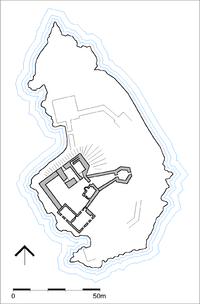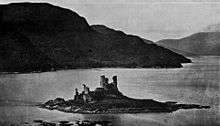Capture of Eilean Donan Castle
| ||||||||||||||||||||||||||||||||
The Capture of Eilean Donan Castle was an land-based naval engagement that took place in 1719 during the Jacobite Rising of that year, and the War of the Quadruple Alliance. A British naval reconnaissance force of three ships attacked the castle of Eilean Donan on the west coast of Scotland, which was held by Spanish troops. After a naval bombardment, the British government forces stormed the castle, and the defenders surrendered. The castle was subsequently destroyed with gunpowder.
Background
The Spanish had sent troops after Cardinal Giulio Alberoni set up the Alberoni Plan a decision to support the Jacobite claims and its Highland allies both to depose George I and enthrone James Stuart.[2] The Spanish landed over 300 marines with various Jacobite commanders such as George Keith (the tenth Earl Marischal). Intending to spread the rising Spanish forces had established a garrison in Eilean Donan Castle, one of Lord Seaforth's residences.[1]
At the beginning of May, the Royal Navy sent five ships to the area for reconnaissance: two patrolling off Skye and three around Lochalsh, adjacent to Loch Duich. Early in the morning on Sunday 10 May, these latter three, the fifty gun HMS Worcester, the forty four gun HMS Enterprise, the twenty gun HMS Flamborough, anchored off Eilean Donan on the north side of Loch Duich.[3]
Assault & destruction

Their first move was to send a boat ashore under a flag of truce to negotiate, but when the Spanish soldiers in the castle fired at the boat, it was recalled and all three ships opened fire on the castle for an hour or more. They then shifted anchorage and waited, the wind blowing a fresh gale.[1]
The next morning (11 May), acting on intelligence from a Spanish deserter, the commanding officer, Captain Chester Boyle of the Worcester, sent the Enterprise up the loch to capture a house being used to store gunpowder but, according to the naval logs, the rebels on the shore set fire to the house as the ship approached. Meanwhile, the other two ships continued to bombard the castle at intervals while they prepared a landing party.[1][4]
In the evening, under the cover of an intense cannonade, the ships' boats went ashore surrounding the castle on all sides and after scaling the walls captured the place against little resistance. The government forces had captured "an Irishman, a captain, a Spanish lieutenant, a sergeant, one Scots rebel and thirty nine Spanish soldiers, 343 barrels of powder and 52 barrels of musquet shot". The Government troops then "burnt several barns etc where they had a quantity of corn for the use of their camp".[1][2]
The naval force spent the next two days demolishing the castle (it took twenty seven barrels of gunpowder). The Spanish prisoners were put on board Flamborough and taken away to Leith and then Edinburgh.[2][5]
The rising ended with the defeat of the Jacobites (poorly provisioned and armed) with the remaining Spanish troops on 10 June at the Battle of Glen Shiel.[6]

Eilean Donan would stand in ruins for over 200 years until 1919 when it was rebuilt, restored and finished in 1932 by John MacRae-Gilstrap.

See also
References
- Citations
- 1 2 3 4 5 Smith p. 215-18
- 1 2 3 Battle of [email protected] By A.H Miller. FSA Scot.
- ↑ Lang & Shields p. 362
- ↑ Battle of Glenshiel@Clan Cameron.org
- ↑ Excerpts from the official logs of HMS Worcester and HMS Flamborough, available at The Clan Macrae website, retrieved Sept 2013.
- ↑ Millar, A. H. (1882). "The Battle of Glenshiel, 10th June 1719" (PDF). Proceedings of the Society of Antiquaries of Scotland. 17: 57–69.
- Bibliography
- Misión en Escocia (pp. 68–74), Muy Interesante 288, May 2005, Abraham Alonso.
- A History of Scotland, J. D. Mackie, p. 273, ISBN 0-14-013649-5
- The Jacobite Attempt of 1719, William K. Dickson (1895)
- Bartlam Smith, Lawrence (1987). Spain and Britain, 1715-1719: the Jacobite issue. Garland Pub. ISBN 9780824019327.
- Lang & Shields, Andrew & Alice (2012). The King Over The Water. Jazzybee Verlag. ISBN 9783849609344.
- External links

